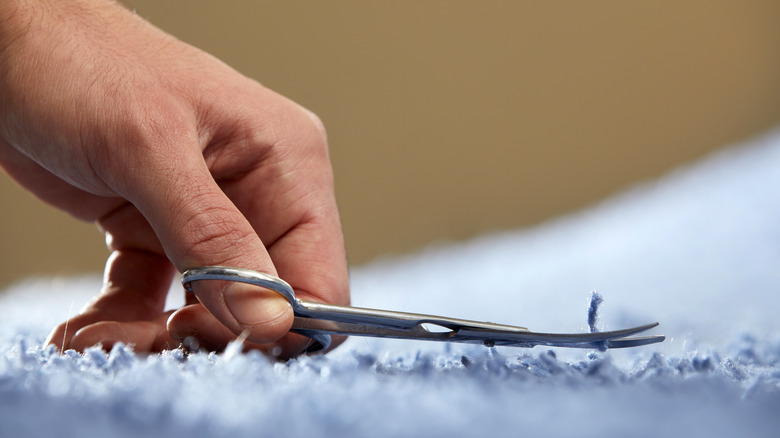The Best Way To Remove Dried Super Glue From Carpet
Having carpets can be a challenge when you drop something on the floor. It's one of the reasons that people are getting rid of carpet flooring. While hardwood and tile flooring can enable you to clean up spills and messes relatively easily, carpets can take quite a bit of extra elbow grease to clean. If you've ever dropped glue on a carpet, you can relate and sometimes, you don't discover the glue until it's already dried up. With superglues which are tougher to remove and dry fast, the job can be tough but it can be removed by using a plastic knife, scissors, or even acetone.
How quickly it will be removed depends on how big the spill is, the state of your carpet, and how stuck on it is to the fibers. For simple or small dried spots of super glue, you may be able to use a simple plastic knife. Use the dull edge of the plastic knife to carefully and gently scrape away as much glue as possible. In simple cases, this may be enough. Then dampen a clean cloth with water, wring it out thoroughly, and wipe the area to remove any residue.
For super glue on surface of carpet only, use scissors
Before diving into super glue removal by using chemicals, assess the damage since you may be able to use scissors only. Keep in mind that removing glue without damaging the carpet takes time and careful attention, and this trick is only suitable for surface glue, meaning the glue hasn't penetrated deep into the carpet fibers. Using scissors on deeply embedded glue can leave unsightly bald spots in your carpet.
If it's just a surface layer and you want to try this method, you'll need special scissors. Opt for sharp, small scissors specifically designed for carpets. Carefully inspect the glued area to confirm it's truly on the surface. If unsure, err on the side of caution and choose a different removal method.
Slip the tip of the scissors under the dried glue, but keep it parallel to the carpet fibers. This ensures you only cut the glue, not the carpet. Then gently lift the scissors handle to raise the entire glue patch slightly. Now, carefully snip off the lifted glue without harming the underlying fibers. Continue lifting and snipping small sections of glue until the entire surface layer is removed. Remember, this method requires precision and patience. If you're hesitant or the glue is even slightly embedded, try an alternative method to avoid damaging your carpet.
Acetone can help loosen superglue
If the superglue goes beyond the surface and into the carpet fibers, you can use acetone or nail polish remover. The truth is that there are a lot of places in your home to use acetone that you've probably been missing. Dip a cotton swab in acetone-based nail polish remover and apply a small amount to the affected area. Work in small sections. Repeat until all the glue is removed. While this method works for stubborn superglue on tough carpets, use caution as acetone can damage some fabrics. It helps to always test on a hidden area of your carpet first.
After removing the bulk of the super glue, tackle any remaining stain with a homemade solution. Mix one teaspoon of ammonia with one cup of warm water. Using a clean, white cloth, dab the solution onto the stain, working from the outside in to avoid spreading it. Don't saturate the area, as this can damage the carpet. Be patient and persistent, repeating the dabbing process until the stain lifts. Then clean the area with water and let it air dry.


